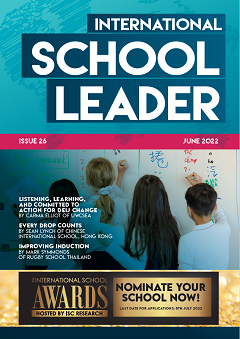By Danau Tanu
Some years ago, I told my parents that I experienced internalised racism as a child. I explained to them that I had felt inferior as an Asian attending an English-medium, international school. They were dumbfounded.
Internalised racism was a foreign concept to them. My parents were both educated in their countries of origin. They had never attended a school where their racial and cultural identities were not represented in the teaching staff and curriculum.
This made it difficult for them to understand my experience. It took several intimate discussions before they did.
Why am I sharing this story?
Blame shifting
I often hear international school administrators and educators blame parents for the structural racism on their campuses. Schools want to change but the parents resist it, or so the argument goes.
But just two years ago, it was largely unheard of for educators to raise their voices against structural racism in the international school sector. Just two years ago, international schools used discriminatory criteria to recruit teachers without giving it a second thought.
It took an alumna to publish a scathing article of the sector at the height of the global Black Lives Matter movement in 2020 for it to became a rallying cry for alumni across the globe, who wrote to their schools and demanded change. I heard that some were initially ignored until they joined forces with fellow alumni to write collective letters.
Only then did educators and administrators begin to publicly acknowledge that racism was an issue on their campuses. They had no choice. Most international educators were just as ignorant as their clientele about these issues just two years ago.
Yet, it did not take long for schools and educators to shift blame to parents. It’s the parents who want white teachers, or so the argument goes.
Make no mistake. Blame shifting is an essential feature of systemic problems. Blame shifting enables us to uphold the flawed system without taking ownership for our complicity in it or responsibility for changing it.
So, what’s the alternative?
Educate ourselves, educate our clients
Instead of stating that it is difficult to dismantle systemic racism because parents resist it, perhaps we could start asking how we can get parents on board. Instead of assuming that parents resist change because they are prejudiced, perhaps we could start asking what parents are actually resisting and why.
For the most part, parents do not understand their own children’s experience of the international school because they did not attend one themselves. Therefore, they do not understand the kinds of changes needed to enhance their children’s educational experience. In this matter, parents are, in fact, not that different from where most international school educators were just two years ago.
Let me illustrate what I mean by making a parallel example.
Transition programmes are built into the fabric of many international schools today. But this was not always so. A few decades ago, neither international educators nor parents were even aware of the need for transition programmes because they had not experienced international mobility in childhood themselves.
This began to change after Ruth Hill Useem, David C Pollock and Ruth E Van Reken published their research about ‘third-culture kids’ and went from school to school across the globe to educate teachers, administrators and parents about the deep psychological impact of mobility on children. Much time, resources and emotional labour was spent to educate school staff and parents to get to where we are today.
Now, imagine if we spent just as much time, resources and emotional labour to educate parents about the negative impact that structural racism has on their children’s sense of belonging and learning experience? Instead of blaming parents for being ignorant and resisting the anti-racist change that schools want to implement, imagine if we engaged them and helped them learn how these changes can create a more inclusive environment that facilitates better learning. Wouldn’t that be more productive?
That said, perhaps international educators had found it easier to see the need for transition programmes because many could sense that their own children needed it. Perhaps this allowed educators to draw on their own experiences to convince parents. Perhaps the shared experience gave educators more credibility and made it easier for parents to trust what they were saying. How does this compare with attempts to get parents on board with anti-racism work? Nearly three quarters of international educators in decision-making roles are white and do not reflect the racial or cultural backgrounds of the majority of their students and their parents. They do not have children of their own who grow up rarely seeing their ethnic and cultural backgrounds represented in the teaching staff and curriculum. They do not have shared experiences upon which they can draw. Sometimes, the anglophone educators and non-anglophone parents do not even share a common language. None of this help establish credibility.
So, what can educators do?
Listen, engage and build trust
Just because parents seem resistant to change, it doesn’t mean they don’t experience the effects of the school’s structural racism. They simply have not made the connection yet.
Parents want the best for their children. And in a world where English fluency is the lingua franca in many of the world’s leading higher-education institutions and in the international job market, it may feel as though giving their children Western education is the price they must pay to be good parents. Among parents who expect their children to repatriate to a non-English-speaking country, there may be some who choose English-medium schools for the enhanced social status that it brings. But there are also many others who, after much research, choose such schools for practical reasons: to maximise their children’s competitive advantage for college and work upon repatriation.
At the same time, many parents also know, for example, that their children struggle to maintain their home language and culture. In some cases, their children outright reject it. When this happens, parents experience a deep sense of loss, which they often don’t know how to address. Sometimes, they don’t realise how great the loss is until their children are in their teens.
Structural racism contributes to these losses. Decades of research shows that maintaining the home language is difficult in the face of a more dominant school language. In the international school context, heavy emphasis on the West and the absence of the rest of the world in the curriculum causes children to see the West as superior and the rest as inferior. Children then internalise this and act upon it.
But parents don’t understand the deep psychological impact of internalised racism. They don’t even know such a thing exists. They don’t know because, like my parents, it was not their childhood experience.
Schools need to help parents make that connection between the cause and the effect of structural racism. To do this, educators need to first educate themselves. Schools need to first listen – with cultural humility – to parents to understand the challenges they face in trying to balance cultural dissonance and giving the best to their child.
Once educators listen, they might be surprised to find that the experience of cultural dissonance is shared. For example, many educators find that their children struggle to socialise when they don’t speak the language that their peers use in the cafeteria. This is merely the other side of the coin of a shared problem.
Once parents feel heard and understood, they will better trust what the school says is good for their children. They may come to see that change is necessary. And educators may come to see that they have more in common with parents than not.
Key learnings
- Listen to and engage with parents
- Learn why parents resist change
- Give learning opportunities to parents
- Ensure the opportunities are linguistically and culturally appropriate

Danau Tanu, PhD, is the author of Growing Up in Transit: The Politics of Belonging at an International School. Currently, she is at the Waseda University Institute of Asia-Pacific Studies in Tokyo as a Japan Foundation Research Fellow. Learn more about Danau’s work at www.danautanu.com or connect with her on Twitter/Instagram @danautanu

